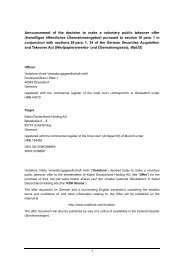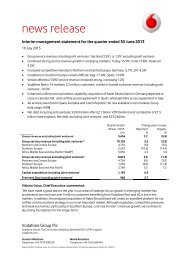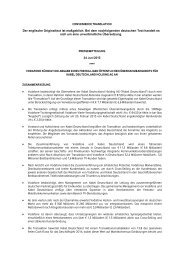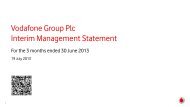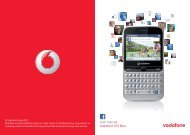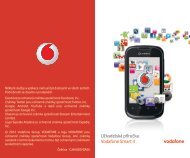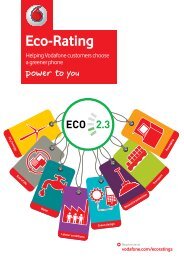Create successful ePaper yourself
Turn your PDF publications into a flip-book with our unique Google optimized e-Paper software.
Moving the debate forward • The Policy Paper Series • Number 8 • April 2008<br />
• The second point picks up from this conclusion: the key<br />
phrase is “given the choice”. It has to be recognised that it<br />
is difficult to treat a model like Gans & King’s seriously from<br />
a policy-making perspective when its conclusions appear<br />
to differ so strikingly from what is observed in practice.<br />
Clearly it is the case that in markets pricing by CPP16 two-way access charges are typically above cost; bill and<br />
keep is the exception, not the rule. However it is critical<br />
to understand that competition between networks can<br />
be expected to arrive at some form of “Nash Equilibrium”<br />
at which neither network can increase its profits by<br />
independently changing its prices. Gans & King show<br />
that if networks have no choice but to set a reciprocal<br />
access charge then they would prefer bill and keep.<br />
However, if either network is free to set its termination<br />
charge independently it is easy to show that the Nash<br />
equilibrium is for both networks to set access charges<br />
above cost, because at a low access charge either network<br />
can gain temporarily by cheating and raising their access<br />
charge to the other network.<br />
• The final point to be highlighted by Gans & King relates to<br />
the interaction between access charges and competition in<br />
the market (in truth this is also highlighted by the original<br />
linear pricing models). In models of imperfect competition<br />
the relationship between prices and costs depends on<br />
the strength of competition between the parties. In a<br />
Cournot oligopoly model (in which competition occurs<br />
in quantities) the number of players in the market<br />
determines the strength of competition. However in<br />
models of the type being discussed here, which are forms<br />
of “differentiated Bertrand” models, competition occurs<br />
in prices and the relationship between prices and cost<br />
is a function of the degree of differentiation between<br />
the competing firms. In a simple differentiated Bertrand<br />
model differentiation is an exogenous factor in the model.<br />
However, what these models show is that when competing<br />
networks charge each other for two-way access the level<br />
of the access charge affects the terms of competition<br />
between them. Competition can be stronger or weaker<br />
depending on the level of access charges. In a “first best”,<br />
perfectly competitive world consumer surplus is typically<br />
maximised when prices equal marginal cost. In the case of<br />
competition between networks it is reasonable to assume<br />
some degree of imperfect competition as being necessary<br />
to recover fixed and common costs. 17 In this case the<br />
consumer surplus generated will depend on the intensity<br />
of competition in the market: the more intense the<br />
competition the nearer the higher will be overall welfare.<br />
The significance of these observations for two-way<br />
access pricing is that in an imperfectly competitive<br />
market consumer surplus will depend on the strength<br />
of competition, while the strength of competition itself<br />
depends on the access charge. Hence it cannot be taken<br />
for granted that consumer surplus is maximised by setting<br />
access charges equal to marginal cost (or by having equal<br />
on-net and off-net call charges).<br />
Gans & King conclude that regulators might be happy to allow<br />
networks to choose bill and keep, because at least it avoids<br />
the problem of high access charges. However, they do not<br />
On-net Pricing in Mobile<br />
discuss the welfare implications of this proposal. Because of<br />
the effect of access charges on the intensity of competition,<br />
Gans & King’s model predicts that consumer surplus increases<br />
with the access charge. The implication is therefore that<br />
setting an access charge above cost can actually benefit<br />
consumers, because the effect of more intense competition<br />
outweighs the inefficiency resulting from pricing calls above<br />
their true marginal cost. 18<br />
The effect of the access charge on consumer surplus in the<br />
Gans & King model is illustrated in Figure 4 below. It should<br />
be noted that the impact on consumer surplus of varying the<br />
access charge is much weaker than the effect on profits.<br />
Figure 4: The effect of access charge on consumer surplus<br />
with network price discrimination<br />
Consumer surplus (100% = access at cost)<br />
105%<br />
103%<br />
101%<br />
99%<br />
97%<br />
Consumer surplus<br />
95%<br />
60% 70% 80% 90% 100% 110% 120% 130% 140%<br />
Access Charge as % of Cost<br />
Source: Frontier model<br />
The importance of these results cannot be under-estimated<br />
because they call into question many of the concerns that<br />
regulators have about two-way access charges being above cost.<br />
It is also worth noting in passing that these results show that<br />
simple regulatory arguments about the “waterbed effect”<br />
have little basis in a proper theory of imperfect competition.<br />
The term was coined by the UK Competition Commission<br />
when considering how much of any movement in F2M access<br />
charges would be passed on to retail customers in the mobile<br />
market. 19 However the concept is equally applicable to the<br />
case of M2M access charges.<br />
The Competition Commission argued that if the outbound<br />
market is imperfectly competitive then the mobile operator<br />
will retain a proportion of any increase in F2M access<br />
charges above cost, indeed an entire chapter of welfare<br />
analysis was based on this presumption. This argument is<br />
profoundly flawed. As I have shown, if the level of access<br />
charge (F2M or M2M) does not affect the intensity of<br />
competition then equilibrium profits will be invariant to the<br />
level of the access charge irrespective of the extent to which<br />
outbound competition is imperfect. Thus in the Competition<br />
Commission’s terms the waterbed will be 100% effective.<br />
However, if the access charge does affect the intensity of<br />
competition then equilibrium profits will change. But as the<br />
intensity of competition could (in theory) increase or decrease<br />
as access charges increase it is clear that the waterbed effect<br />
is not limited by 100%. Gans & King show that with tariff<br />
differentials and Hotelling competition the waterbed effect<br />
from M2M access charges could exceed 100%. That is, an<br />
increase in access charges is more than fully passed on to<br />
subscribers because of the intensifying of competition.<br />
15



